The evolution of customer service is upon us. Generative AI, powered by advanced Large Language Models (LLMs) like GPT-4, is reshaping how businesses interact with their consumers. From providing human-like text and voice responses to handling complex queries with unprecedented efficiency, it isn’t merely a passing trend – it’s an accelerator for transforming client experience (CX).
With upcoming advancements like GPT-5 promising even greater capabilities, possibly approaching “superintelligence,” the potential of Generative AI for customer service is only beginning to unfold. Therefore, early adopters of AI-driven systems are strategically positioned to leapfrog their competition and redefine industry standards.
This guide will take you on a fascinating exploration of how generative solutions disrupt traditional support processes and pave the way for a new era of user-centric assistance. We’ll look into 25+ groundbreaking use cases, from chatbots and virtual agents to voice assistants and personalized recommendations. Whether you’re just starting to explore Gen AI or looking to expand its implementation, this article will equip you with the knowledge and strategies to exploit the benefits of this avant-garde technology and ensure top-tier customer journeys.
Table of Contents
Why Generative AI is a Must-Have for Customer Service, According to the Pros
The State of Domain and the Promise of Gen AI
Customer service is at a crossroads. On one hand, consumers are increasingly frustrated with traditional support models. A OnePoll survey revealed an astonishing 62% of clients have abandoned a company due to poor assistance. Furthermore, 65% find issue resolution too time-consuming and laborious. Such dissatisfaction is impacting brand loyalty and costing businesses billions in lost revenue.
On the other hand, Generative AI is emerging as a beacon of hope, destined to alter this industry. Gartner predicts that by 2026, 50% of customer service and support organizations will have implemented GenAI-driven virtual assistants (VA) for both agent internal and client-facing tasks. The rapid adoption is fueled by the technology’s capacity to enrich dialogues, automate routine functions, and empower managers with real-time insights.
What’s more, the benefits of GAI extend far beyond operational efficiency. Gartner also projects that by 2032, the market for VAs in contact centers will reach a staggering $7.4 billion. This highlights the growing acknowledgment of this technology’s ability to boost revenue and elevate user satisfaction.
The demand for generative solutions is not just a trend; it’s a consumer-propelled imperative. 82% of customers expect companies to implement digital applications to enhance their offerings. Moreover, 80% are comfortable with human agents utilizing Generative AI to deliver better guidance. And 74% believe it can seamlessly bridge the gap between chatbot interactions and support representatives’ aid.
Thus, technology’s potential is undeniable. It promises to address the pain points plaguing conventional client care, offering a path towards enhanced productivity, hyper-personalized experiences, and ultimately, increased retention and sales.
Experts Weigh In: The Real-World Impact of Generative AI
The influence of artificial intelligence on client care isn’t just theoretical; it’s tangible, and it’s happening now. The Master of Code Global’s technological experts offer firsthand insights into this disruptive tech.
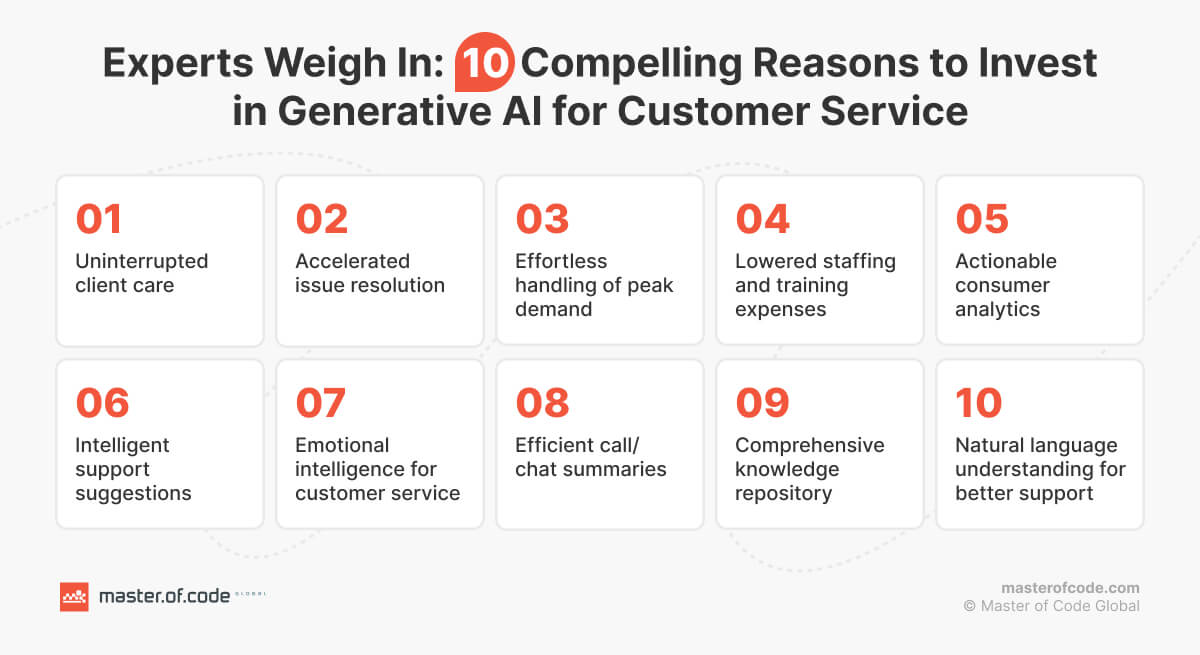
Petra Gal, a seasoned Conversation Designer, observes: “GAI is already enhancing support operations, making them faster and more effective. It gives agents real-time suggestions and recommendations during communication. Besides, LLM-fueled chatbots handle routine queries, freeing up employees for complex issues. We’re also seeing the power of sentiment analysis in uncovering valuable patterns in conversations.”
Daria Vynohradina, our Project Manager, highlights the practical advantages: “Generative AI is a cost-effective solution that provides round-the-clock aid without the limitations of human specialists. It effortlessly handles high volumes of inquiries, collects and analyzes client records, and ultimately helps businesses refine their products and services.”
Olga Hrom, a PM with expertise in digital applications, emphasizes the versatility of generative systems. “GenAI is a multifaceted tool that excels at text summarization, data processing, and natural language communication. This makes it ideal for streamlining agent workflows, building elaborate knowledge bases, and ensuring more engaging and individualized interactions.”
At the same time, Viktoriia Tymoshchuk, an AI strategist and PM, advises a measured approach. “The buzz around the technology is real, but careful implementation is key. Hybrid interfaces, where Gen AI complements intent-trained models, are proving the most fruitful. For sensitive industries like banking and healthcare, co-pilot solutions, where artificial intelligence assists but remains under human supervision, suggest a balanced strategy.”
This collective wisdom underscores that intelligent technology is not just a future possibility. It’s a present-day instrument that is currently redefining customer care. By empowering agents, improving efficiency, and delivering personalized experiences, it is set to reshape the landscape and drive significant business value.
Advantages Overview: Traditional vs Generative AI for Customer Service
Generative technology marks a significant evolution from traditional AI in client care, offering unique capabilities that elevate CX and drive operational efficiency. Let’s explore the key features that set these solutions apart.
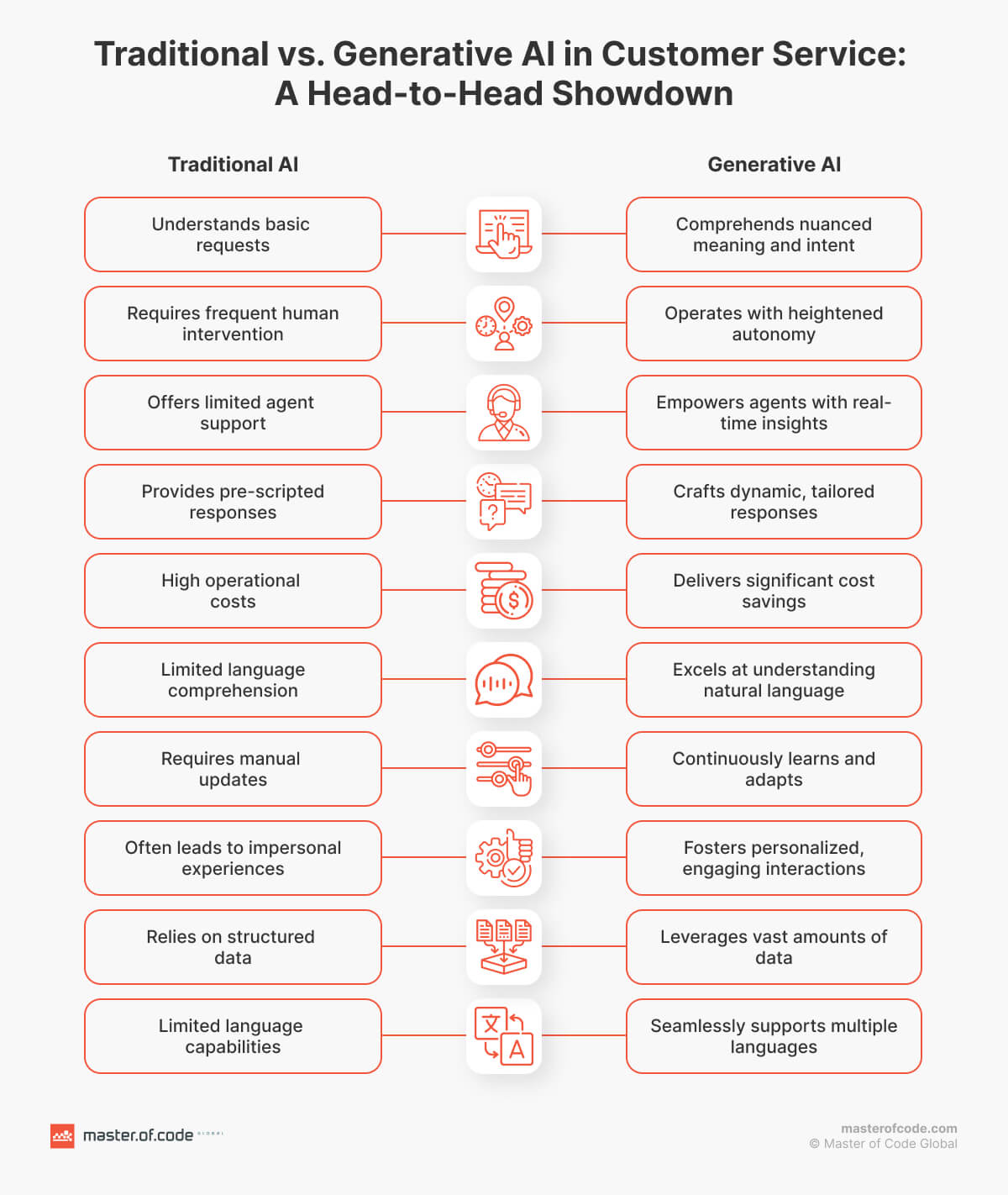
Contextual Understanding and Personalization
Unlike traditional AI, which relies on predefined rules and keywords, GAI comprehends the complexities of consumer queries, even when using colloquialisms or complex language. This deeper understanding enables the delivery of more relevant and customized replies. Brands utilizing it foster a sense of recognition and care that buyers crave. In fact, research from Salesforce reveals that 79% of clients are willing to share personal information if it yields personalized services.
Enhanced Autonomy and Efficiency
The technology also minimizes the dependence on human agents for routine tasks. It autonomously handles a wider range of inquiries, which is paramount during peak hours. This shift streamlines support processes and allows managers to focus on high-value requests. A study by Stanford and MIT highlights AI’s positive impact on agent productivity. There is a 13.8% increase in successfully resolved chats per hour when the technology is employed. Furthermore, it has been shown to accelerate the learning curve for newer workers, lower employee turnover, and curtail escalations requiring supervisor intervention.
Richer, More Engaging Interactions
Another vital benefit is the capacity to create more immersive and interactive experiences. By incorporating multimedia elements into responses, intelligent systems transform dialogues into captivating conversations. For instance, users facing technical issues can receive video tutorials, while those exploring products can view images and videos showcasing them in use. This enriches the shopping journey and fosters a deeper connection with the brand.
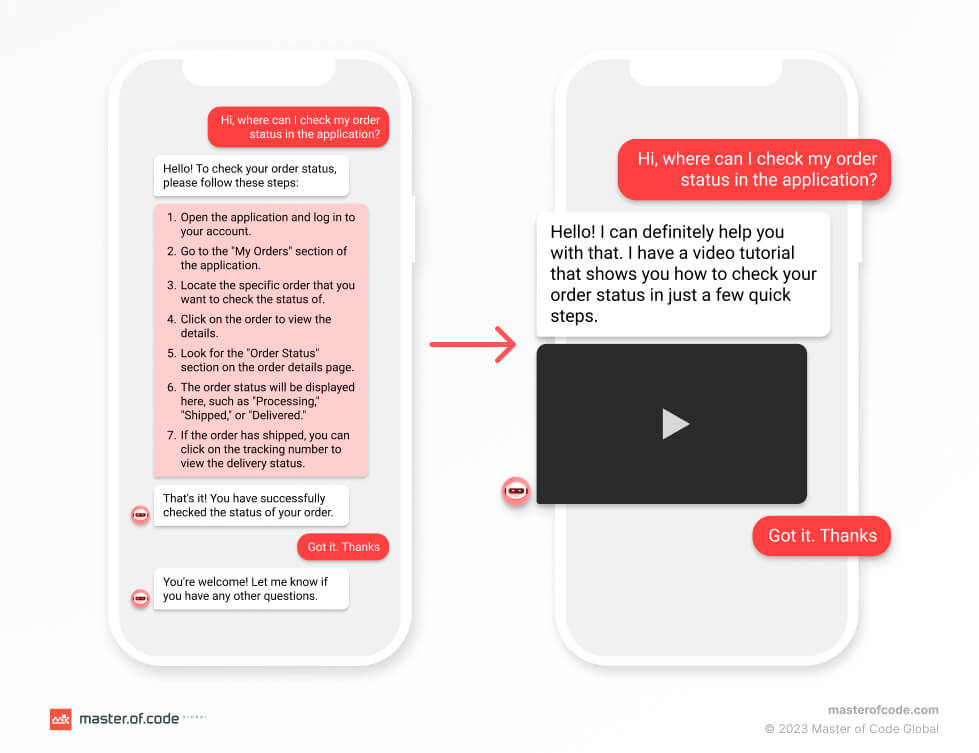
Cost-Effective Solutions
GAI can also significantly reduce support costs. Traditional models often entail high operational expenses due to extensive manual effort, training, and staffing requirements. Generative algorithms, on the other hand, can automate various operations. Such an optimization reduces the need for oversight and lowers overhead. A report by Cloudtask estimates that an in-house team of four client care representatives can cost upwards of $259,955 per year. Adding a customer service manager at a salary of $45,726 and other fees like hiring, office space, software, and hardware can push the total sum to $259,955 yearly. Intelligentization offers a more economically viable alternative, depending on the specifications.
Natural Language Understanding and Multilingual Support
The technology is equally good at interpreting messages, even when the clientele uses complicated phrasing, slang, or terminology. This leads to more accurate and satisfying exchanges, improving customer satisfaction rates.
Additionally, Generative AI enhances multilingual aid by enabling real-time communication in numerous languages. This is essential in a global marketplace where 79% of contact centers, as per ICMI analysis, interact with consumers who are not fluent in the primary lingo(s) offered. GAI’s ability to diversify dialogue and provide tailored guidance in multiple languages results in increased loyalty and retention.
Choosing the Right Approach for Your Company
Both traditional and Generative AI bring distinctive strengths to the table. The optimal choice depends on your specific use cases and desired outcomes. Whether you opt for one or a combination of both, discovering their distinct powers is crucial to making an informed decision.
The Strategic Risks of Skipping Generative AI for Customer Support
As the traction for the technology keeps growing, businesses that remain on the sidelines are susceptible to not only missing out on its benefits but also facing tactical vulnerabilities in an escalating market environment.
- Competitive Disadvantage
CEOs and executives are increasingly prioritizing Generative AI for customer service. In fact, 85% of them anticipate direct interactions involving the technology within two years. Firms that do not invest in intelligentization now risk falling behind competitors who use smart systems to enhance engagement and efficiency. This edge will be critical as artificial intelligence continues to transform user expectations and standards. - Declining Customer Satisfaction
Modern clients expect quick, accurate, and bespoke assistance. Generative AI can meet these needs by providing real-time, 24/7 aid and tailored responses as per individual data. Without Gen AI, organizations may struggle to maintain high levels of advocacy and client lifetime value. This could lead to longer wait times and less personalized communication. Such a decline in quality can also result in lower retention efforts. - Missed Innovation Opportunities
The technology offers powerful information analysis capabilities to identify trends and emerging possibilities. Companies overlooking Gen AI will miss out on these insights, hindering their ability to introduce new ideas and stay ahead of the curve. This can affect product development, marketing strategies, and overall business expansion. Moreover, such firms are left at a considerable disadvantage compared to innovation advocates who can rapidly adapt and innovate based on intelligent analytics. - Scalability Challenges
As enterprises grow, the need to build a future-ready, high-performing support team becomes paramount. Generative solutions enable seamless adaptability by handling an increased volume of conversations without a proportional increase in costs or resources. Businesses that overlook Gen AI will encounter major hurdles in scaling their processes, leading to probable service disruptions during peak periods. The lack of brand proliferation possibility can impede growth and limit market opportunities.
In conclusion, organizations that neglect Generative AI for customer support now will likely face significant competitive, operational, and strategic disadvantages in the future. The potential to boost productivity, accentuate the brand’s distinctiveness, drive domain improvements, and scale operations makes the technology a vital investment for staying relevant in an AI-driven marketplace.
Effective Gen AI Deployment in Customer Service: Key Stages
Having explored the potential pitfalls of neglecting the innovation, it’s clear that its adoption can significantly enhance your consumer service operations. Here at Master of Code Global, with our extensive experience in developing Generative AI tools, we’ve outlined a 7-step process to ensure a smooth and successful implementation for your client care needs. Let’s unpack each step to gain a deeper understanding of the strategy.
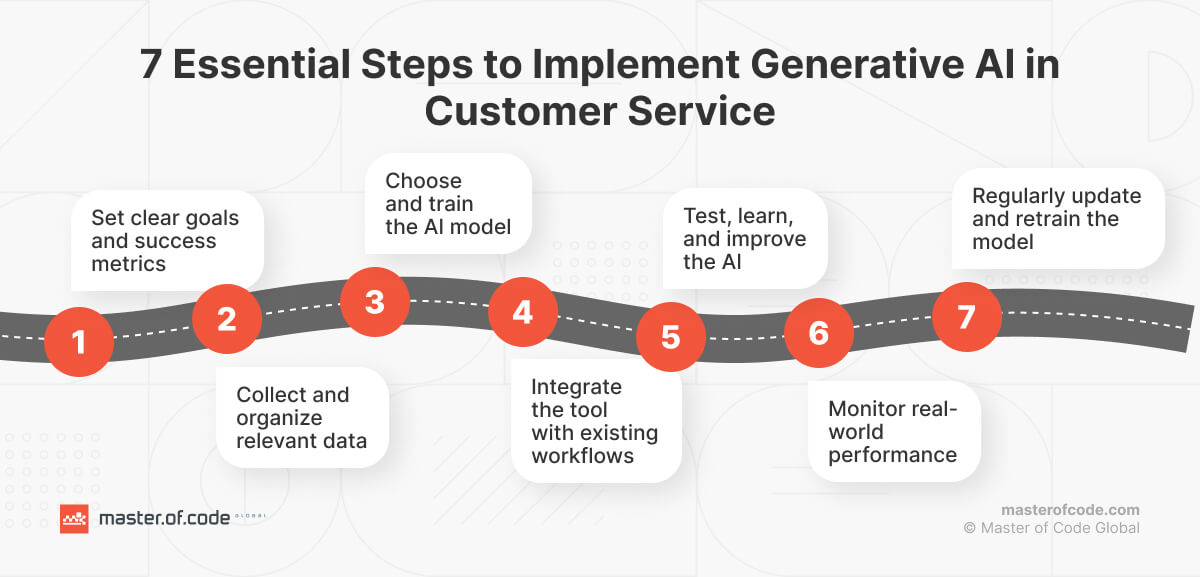
Step 1: Diagnose and Define as the Pre-Implementation Assessment
Firstly, complete a thorough examination of your current customer service landscape. This involves identifying elements creating friction or frustration for both common users and agents. Analyze common questions, pinpoint repetitive tasks that bog down managers, and evaluate areas with high wait times or low-resolution rates. Once you have a clear understanding of your pain points, determine the exact objectives you want Generative AI to achieve. Do you aim to deflect simple inquiries with chatbots, personalize interactions through virtual assistants, or improve resolution times with automated issue diagnostics? Setting SMART (Specific, Measurable, Achievable, Relevant, and Time-bound) goals will guide your adoption journey.
Step 2: Data – The Fuel for GAI Success
The next phase is gathering the raw materials that will power your intelligent engine – data. We recommend collecting customer interactions across various channels along with feedback surveys and past service records. Ensure the dataset is cleansed of any errors, inconsistencies, or outdated information. This might involve removing irrelevant entries or anonymizing sensitive data. Remember, “garbage in, garbage out” – clean and relevant info is crucial for training effective models that deliver accurate and natural-sounding responses.
Step 3: Choosing and Training the Tool
The success of your solution hinges on selecting the right model for the job. Different systems excel in varying tasks. For instance, for complex inquiries requiring in-depth understanding and natural language responses, a large language model trained on historical data might be a better fit. Once you’ve identified the optimal Generative AI, it’s time for training. This involves feeding the prepared datasets into the LLM and allowing it to learn and refine its replies. Fine-tuning the algorithm through iterative testing ensures it performs at its peak, accurately comprehending and responding to queries in a human-like manner.
Step 4: Bridging the Gap for Seamless Integration
For a smooth experience, your Gen AI-based solution needs to integrate flawlessly with your existing infrastructure. Ensure compatibility with your CRM, ticketing software, and communication channels. Imagine a customer using a chatbot to initiate a service request. Ideally, the bot should create a ticket within your system and automatically populate relevant client information retrieved from your CRM. This level of integration allows the Generative AI to function frictionlessly within your established workflow.
Step 5: Testing and Refining
Once integrated, rigorous testing is crucial before bringing your GAI tool to real-world use. Start by simulating various customer scenarios and feeding the system a diverse range of inquiries. Then analyze its responses for accuracy, clarity, natural language flow, and adherence to your defined goals. Gather feedback from both agents and clients during this phase. Such an approach enables you to refine the solution, improving its features and capabilities. Remember, Generative AI is an ongoing learning process. Continuous improvement through evaluation and response assessment is key to maintaining high service quality and a positive CX.
Step 6: Launching and Monitoring
Following successful testing, it’s time to deploy your intelligent solution across your customer care channels. This might involve introducing the AI chatbot on your website, integrating it with your messaging platform, or even piloting it with a specific agent team. However, the journey doesn’t end with the launch. Closely monitor performance, analyzing key metrics like resolution rates, satisfaction scores, and agent feedback. Regular analysis helps identify areas for further refinement and ensures the system continues to meet your standards.
Step 7: Advancing and Expanding
The final stage focuses on ongoing optimization and upscaling your intelligent system. Use the performance metrics and customer feedback you’ve gathered to enhance the model. This might involve retraining LLM with new data or fine-tuning its responses based on real-world interactions. As your Generative AI proves successful, consider growing its reach. Could it be applied to other areas of client service, such as product recommendations or post-purchase support? Perhaps it could be scaled to other departments within your organization. By continuously adapting and expanding, your solution can become a powerful tool for driving consumer satisfaction and overall business success.
Mastering Generative AI: Pro Tips from Our Project Managers
A few additional considerations from our PMs can further enhance your artificial intelligence journey:

- Data quality is paramount. As Olga Hrom highlights, the accuracy of the data you provide to train your model is crucial. Clean, well-validated datasets from diverse sources lead to a more precise and knowledgeable intelligent solution.
- Embrace an iterative approach. As Olga also mentions, the initial stages might produce imperfections or hallucinations. Client feedback during User Acceptance Testing (UAT) is essential for refining the AI and ensuring a robust final version.
- Transparency builds trust. Following Olga Bayeva’s advice, be upfront about your tool’s capabilities. Inform customers when they’re interacting with Generative AI, setting realistic expectations and mitigating potential risks.
- Continuous learning is key. As Daria Vynohradina emphasizes, successful implementation is a marathon, not a sprint. Your solution will require ongoing training with new data and feedback to maintain precision and adapt to evolving needs.
By following these 7 steps and incorporating the valuable insights from our Project Managers, you’ll be well-equipped to navigate the implementation of AI in customer service and achieve your desired outcomes. Remember, successful adoption is a lasting process. Master of Code Global stands ready to partner with you throughout these stages, offering ongoing support and guidance to ensure your solution continues to learn, adapt, and deliver exceptional experiences.
Willing to get the most out of Gen AI? The next section explores compelling use cases and real-world examples to inspire your rollout strategy.
Industry-Agnostic Applications of Generative AI for Customer Service
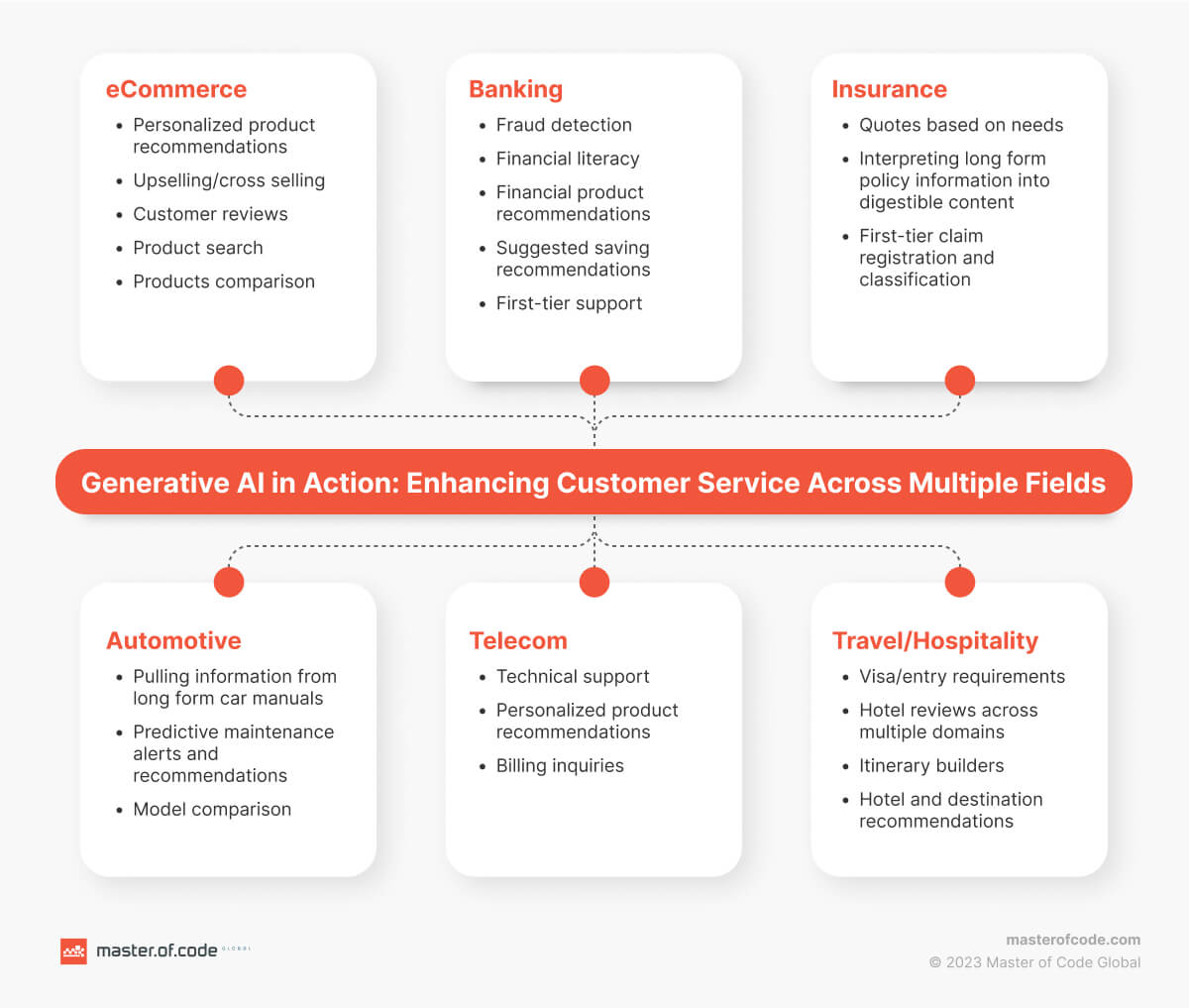
Key Use Cases for Every Business
Generative AI-Powered Bots
These intelligent customer support chatbots go beyond basic interactions by crafting personalized welcome messages that reference past exchanges. They analyze transcripts to detect client sentiment, proactively addressing dissatisfaction. Through reviewing the records and user preferences, they send individualized offerings and generate dynamic FAQs that adapt in real-time. Besides, these bots mimic human talks, elevating engagement and building rapport with buyers.
For example, BloomsyBox.com, a floral subscription company, utilized a Generative AI eCommerce chatbot for their Mother’s Day campaign. The bot asked users five questions daily, and the first 150 users who answered all questions correctly won a free bouquet. This initiative led to a 60% engagement rate, with 78% of winners claiming their prize.
Voice-Enabled Artificial Intelligence
The power of Generative algorithms extends to voice interactions as well. AI in the call center understands diverse accents and dialects, ensuring accurate transcription and interpretation of queries. It facilitates hassle-free voice-triggered transactions, like booking appointments or making purchases. By analyzing tone, it chooses empathetic reactions to user concerns. Real-time language translation during calls breaks down communication barriers, while tailor-made voice messages accommodate personal requirements.
Multimodal Interactions
Generative AI allows for a truly immersive customer service experience by combining voice, text, and visual cues. Consumers can upload images for troubleshooting or coordinate complicated transactions across multiple channels. They can also enjoy realistic product demonstrations that combine visuals with voice explanations. Seamless switching between media guarantees a smooth and uninterrupted digital journey.
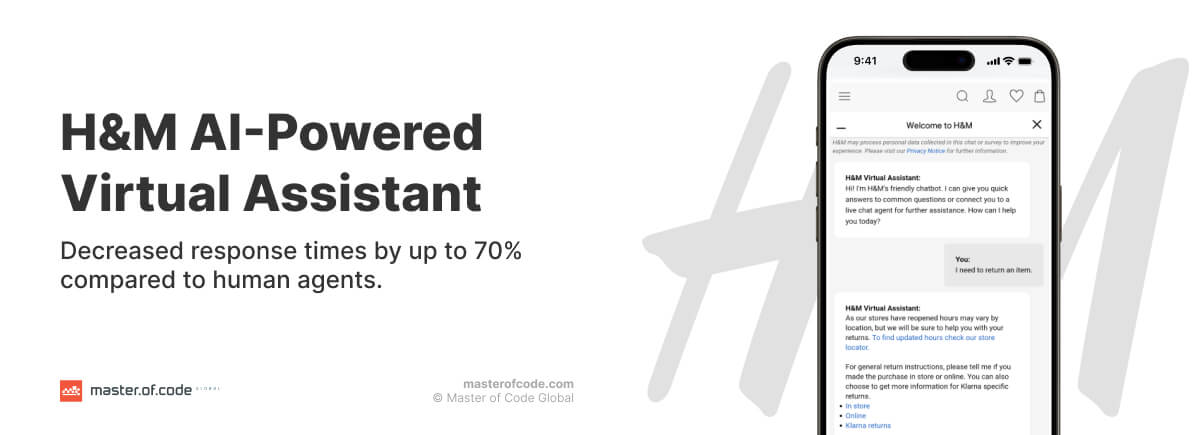
An illustration of this use case is H&M’s AI-powered virtual shopping assistant. Available on their website and mobile app, it has slashed response times by an impressive 70% compared to human agents. This intelligent bot provides bespoke outfit ideas, sizing advice, and answers style-related questions. Shoppers can also utilize voice search in the mobile app for added convenience.
Personalized Product Recommendations
The technology also excels in enhancing the shopping process. It analyzes purchase history, browsing patterns, and demographic data to suggest appropriate products. It delivers tailored tips based on real-time conversations and buyer intent. Visual prompts and item comparisons empower clients to make informed decisions. Furthermore, advice for complementary items or upgrades, as well as special discounts or promotions, enhances the overall process.
An electronics retailer partnered with Master of Code Global and Infobip to develop an Apple Messages for Business chatbot, capitalizing on the benefits of this use case. Their Generative AI-driven bot examines consumer inquiries and provides customized item suggestions. Seamlessly integrated with Shopify, the assistant facilitates purchases and offers a smooth transition to human agents when needed. This implementation led to an 80% satisfaction score and an 84% engaged session rate.
FAQ Automation
Additionally, Gen AI optimizes customer support by instantly answering common questions, reducing wait times, and improving satisfaction. It guarantees 24/7 access to self-service options, even outside of business hours, freeing employees to manage escalated situations. The technology continuously learns from each dialogue to heighten the precision and relevance of responses, while offering FAQs in multiple languages to cater to a global audience.
A prime example of this is JetBlue. A leading US airline partnered with ASAPP to implement an LLM solution in their contact center. The AI-optimized tool automates and enhances their chat channel, resulting in an average time saving of 280 seconds per interaction. This translates to a remarkable 73,000 hours of agent time saved in a single quarter.
Similarly, Wealthsimple, a financial services company, has implemented an AI-based chatbot to effectively handle the influx of inquiries, particularly during peak periods. The bot, trained on the organization’s extensive knowledge base, handles approximately 80,000 client questions monthly, allowing human agents to focus on complex and high-value interactions. This strategic approach has not only improved efficiency but has also resulted in a 10-point increase in CSAT scores.
Customer Journey Analysis and Retention
By identifying pain points and bottlenecks, intelligent algorithms reveal areas for advancement. It tracks communication across numerous touchpoints to gain a holistic view of CX, predicting behavior and anticipating needs. This enables proactive and custom engagement. Similarly, it measures the impact of interventions on retention and revenue. Data is used to inform marketing and sales strategies for optimization.
Boosting Agent Efficiency
Human agents get empowered with on-the-spot suggestions and materials during customer interactions. Generative solutions automate repetitive tasks like data entry and case routing, allowing managers to devote more time to other activities. Summarizing the dialogues streamlines handoffs and ensures continuity of service. Moreover, it offers personalized training and coaching as per individual performance reports and monitors communication to identify aspects for improvement.

At Octopus Energy, a UK-based supplier, Gen AI is integrated into customer care channels and reportedly handles inquiries as effectively as 250 human managers, even achieving higher satisfaction ratings. Greg Jackson, the company’s CEO, describes using the technology as a “superpower” for employees, enabling them to focus on building more meaningful connections.
Look into 4 other examples of energy companies implementing artificial intelligence to serve customers better
Heathrow Airport is another example of how GAI enhances workers’ productivity. The airport has deployed four dedicated assistants to provide hyper-customized support across various passenger services. These include a synthetic design assistant, personalized chatbots, and knowledge assistants for client care and product information. By augmenting human capabilities, the tools elevate the travelers’ experience and smooth airport operations, setting a new standard for the industry.
Automated Knowledge Management System
Lastly, GAI acts as a centralized and organized repository of company knowledge, accessible to both agents and customers. It automatically updates the database with new info and insights. As a result, employees quickly find relevant answers. Brands improve the accuracy and consistency of information provided to consumers. Plus, they reduce the time and resources required to maintain and update the help center.
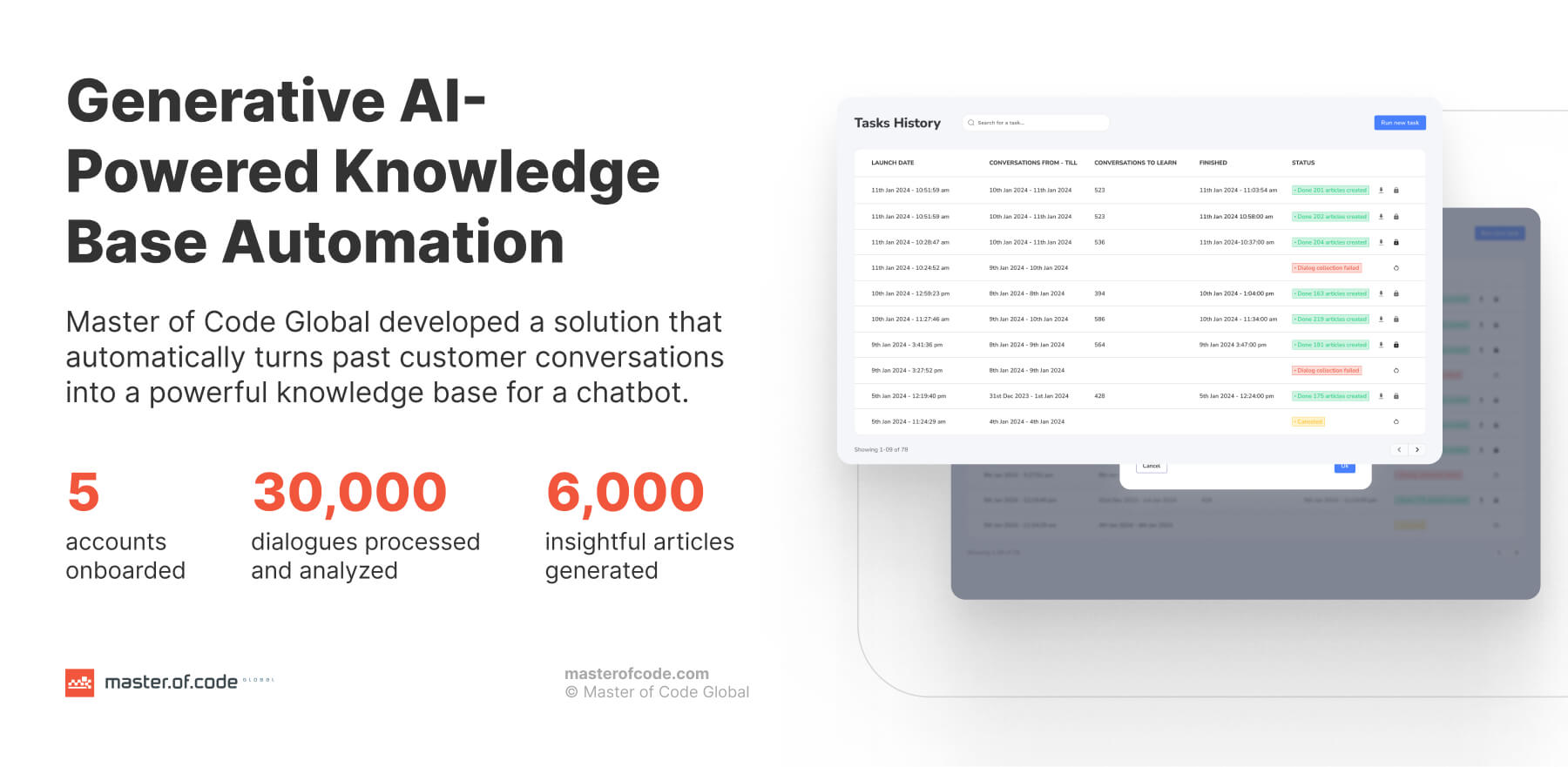
For instance, Master of Code developed a knowledge base automation solution for a leading Conversational AI platform. This algorithm employs large language models to automatically analyze customer-business interactions. It then generates helpful articles based on frequently asked questions and the best agent responses. In just a short period, this application has successfully onboarded five accounts, processed 30,000 dialogues, and 6,000 insightful materials.
Another example of this use case in action is a Generative AI-powered Slack chatbot we designed for an enterprise-level technology organization. This internal information repository tool allows workers to swiftly retrieve data about company products and services, from HR policies to technical specifications.
eCommerce
Having explored the fundamental applications of Gen AI, let’s shift our focus to the eCommerce sector. Online retailers are adopting this advanced technology in numerous ways, from dynamic pricing and inventory management to virtual try-on experiences and highly personalized marketing. Let’s examine three of the most notable use cases in detail.
- Upselling/Cross-selling
Language models, trained on extensive datasets of customer behavior and product relationships, excel at recommending complementary or upgraded entities. By analyzing real-time shopping cart data, browsing history, and demographic information, these algorithms generate appropriate suggestions, increasing the likelihood of additional purchases. This not only boosts average order value but also enhances CX by showcasing items they might not have discovered otherwise. - Product Search
GAI is moving beyond simple keyword matching. Utilizing natural language processing (NLP) and semantic understanding, these systems can interpret complex queries, synonyms, and even misspellings. By grasping the intent behind the inquiry, the technology delivers more accurate and relevant results, improving the buying process and maximizing conversion rates. Additionally, it can enable visual search capabilities, letting shoppers discover products through images or descriptions. - Product Comparison
By scrutinizing specifications, features, and reviews, LLM solutions can create extensive comparison tables and summaries, highlighting key differences and similarities. This helps buyers make educated choices according to individual needs and preferences, boosting confidence in their purchases and reducing the probability of returns. Moreover, Generative AI can support interactive benchmarking, allowing customers to ask questions and receive real-time answers based on the assessments.
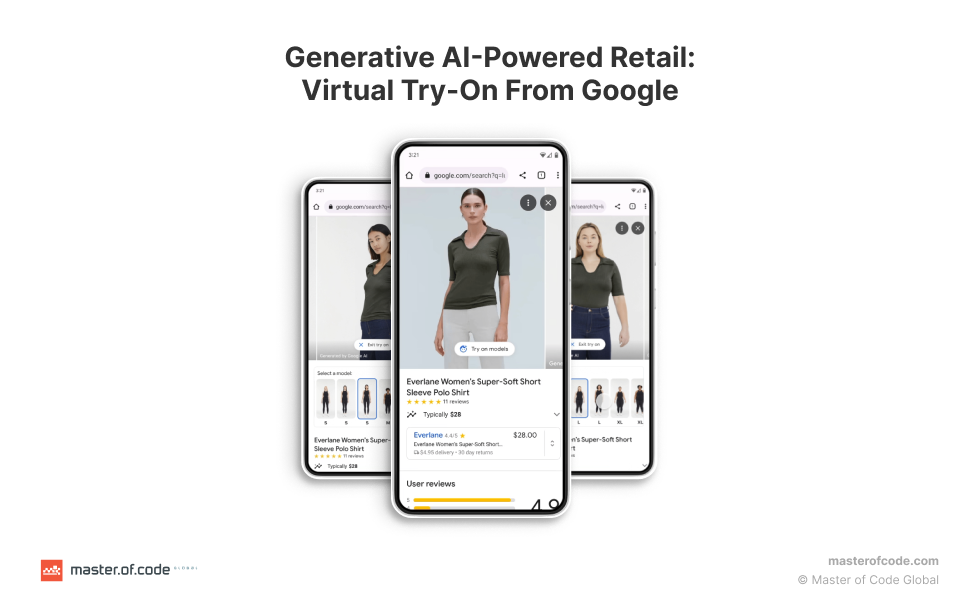
The best-known example of businesses using algorithms to enhance the shopping journey is Google’s virtual try-on feature. This tool accurately shows how clothing would look on a diverse range of real models with varying body shapes, skin tones, and sizes. Shoppers can select a model that resonates with them to visualize how the item might fit, providing a more personalized and confident online shopping experience.
Healthcare
In the medical sector, this technology is also acting as a trigger for positive change. It helps with streamlining processes and fundamentally improving care quality. Let’s explore three use cases illustrating this impact.
- Medical Report Generation
Gen AI efficiently analyzes patient data, medical history, and test results. It then creates exhaustive reports, saving physicians valuable time. This not only ensures accurate and standardized documentation but also improves diagnosis and treatment plans. - Virtual Patient Education
Virtual assistants provide personalized learning modules and interactive tailored content. These companions can answer patients’ questions in a clear and informative way, deliver prescription reminders, and track adherence. They can even offer emotional support, leading to increased patient engagement. - Drug Discovery and Development
Generative AI in pharma is accelerating medication creation by at least 25-30%. This is possible thanks to its capability to analyze massive datasets of biomedical data, like disease pathways or protein interactions. Researchers can identify promising drug targets and develop novel molecular structures at an unprecedented speed. Traditionally, this process has been slow and expensive, often relying on trial and error. For example, Recursion adopted AI to predict targets for 36 billion compounds, achieving in a week what would have taken 100,000 years using conventional methods.
An excellent illustration of employing Generative AI in healthcare is Google’s Med-PaLM-2 chatbot. Tested at Mayo Clinic, it aims to enhance staff backing. It offers symptom-based diagnoses and performs tasks such as summarizing consultation notes and organizing patient data. Trained with medical demonstrations and exam answers, the bot is well-prepared for precise health-related conversations.
SmileDirectClub, a top teledentistry firm, went even further. They shifted from third-party providers to an in-house AI team. This move allowed them to automate treatment planning, cutting the time from 45 to under 10 minutes while boosting consistency and accuracy. They are now exploring the technology for contact center call summarization.
Banking
Clearly, the banking and finance sector is not lagging behind in the race to adopt Generative AI. Numerous institutions are experimenting with these transformative algorithms, unlocking a wealth of promising applications:
- Fraud Detection
Generative solutions analyze extensive transaction data in real-time, identifying patterns and anomalies indicative of fraudulent activity. This proactive method enables banks to prevent scams before they happen, protecting both clients and the institution. - Financial Literacy
AI-driven tools can offer personalized financial education, helping users make prudent decisions. By examining individual data and tailoring advice, these algorithms guide budgeting, saving, investing, and debt management. This improves financial knowledge and strengthens the bond between consumers and their banks. - Saving Guidance
By analyzing spending habits and financial goals, smart systems provide customized saving tips. This approach helps clients optimize their finances, achieve their objectives, and build a solid economic foundation. - First-tier Support
AI banking chatbots handle basic inquiries, offering immediate responses to common questions, account balances, and information about products. This allows human representatives to address complex issues, improving overall efficiency and customer satisfaction.
Here are some notable examples of major brands profiting from effective intelligentization:
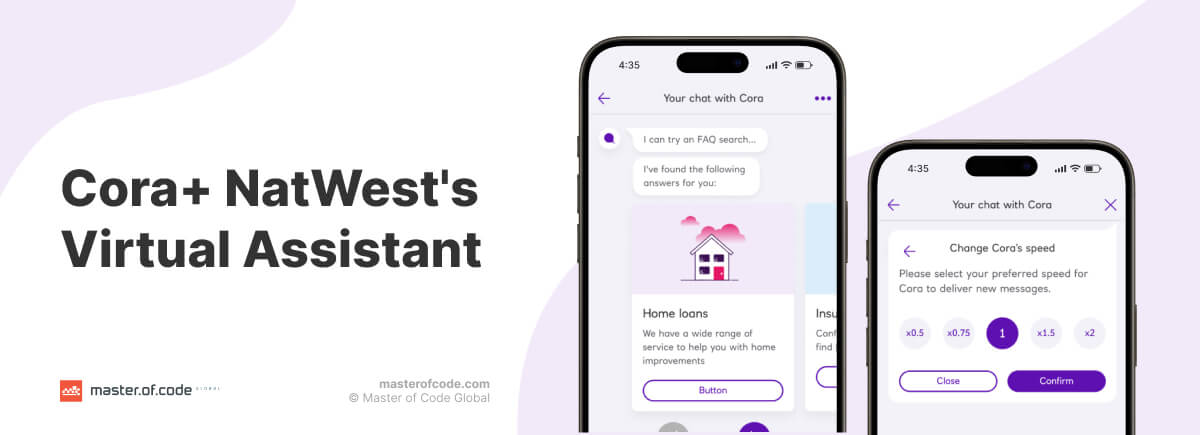
- NatWest, a leading UK bank, is upgrading its virtual assistant, Cora, with generative capabilities. The enhanced assistant, Cora+, will offer a more conversational and personalized experience, accessing a wider range of secure information to address customer queries on products, services, and even career opportunities.
- Mastercard is utilizing cutting-edge Generative AI to detect potentially compromised cards at twice the speed of traditional methods. By analyzing billions of transactions across millions of merchants, their intelligent algorithms can uncover complex fraud patterns that were previously undetectable, safeguarding cardholders and the financial ecosystem.
- John Hancock has partnered with Microsoft to implement Azure Bot Service in their call centers. AI-enhanced solutions handle common client questions, reducing call volumes and allowing agents to dedicate more time to high-priority activities. This has led to improved digital well-being, reduced wait times, and a more efficient contact center operation.
Find out how other 11 global financial organizations successfully utilized Generative AI in diverse fields
Telecom
According to a report by Altman Solon and AWS, highly impactful use cases within this industry include search term generation, customer chatbot integration, contact center documentation, and guided employee assistance for knowledge management and diagnostics. These applications are driven primarily by the promise of increased efficiency and productivity (41%), cost savings (20%), and gaining a competitive advantage (18%). Here are a few specific scenarios:
- Technical Support
Generative solutions go beyond simple troubleshooting scripts, relying on the ability to comprehend natural language and access vast information repositories to provide tailored resolutions. Clients can describe their concerns in their own words, receiving step-by-step guidance or even visual aids to resolve bottlenecks quickly and effectively. - Proactive Outreach
This advanced technology can analyze client data to identify probable issues or needs before they escalate. As a result, telecom companies proactively reach out to subscribers with personalized offers, service upgrades, or remedies for possible setbacks, enhancing user satisfaction and loyalty. - Billing Inquiries
It also streamlines invoice questions by providing clear explanations of charges, payment options, and potential discounts. Consumers interact with AI-powered interfaces that grasp their particular requests and deliver easy-to-understand answers, reducing the need for escalation to human representatives.
Travel and Hospitality
The research reveals that 79% of industry professionals are adopting this technology to improve customer satisfaction, while 67% are focused on process optimization. This integration is already yielding impressive results, with operational efficiency gains of 20% to 40% and revenue increases of 5% to 20%. Let’s explore some specific use cases of Generative AI in the travel industry.
- Visa/Entry Requirements
Intelligent systems provide travelers with real-time, up-to-date information on visa regulations, document checklists, and other essential details for their destination. By eliminating the need for manual research and presenting precise, in-depth data instantly, GAI simplifies preparation and empowers people to make sound decisions. - Hotel Reviews and Recommendations
AI-driven platforms aggregate and analyze feedback from various online sources, offering travelers a thorough and unbiased overview of ratings, amenities, and guest experiences. They can select capacities that match their tastes and priorities. Additionally, by incorporating user-generated content and personal preferences, the technology curates hyper-personalized suggestions, ensuring truly unique trips. - Travel Assistance
GAI acts as a virtual travel companion, crafting customized itineraries based on one’s taste and budget. These models recommend activities, dining options, and attractions while also considering factors like weather and traffic conditions. The ability to dynamically adjust schedules as per unforeseen circumstances ensures a smooth and enjoyable experience. - Itinerary Builders
Beyond suggestions, Gen AI can now create complete travel itineraries. By integrating with booking platforms and leveraging extensive datasets, these smart solutions develop detailed plans that include flights, accommodations, excursions, and transportation, all tailored to the traveler’s budget and likings. This saves time and effort for both travelers and agents, streamlining the planning process.
By merging AI into its reservation infrastructure, Delta is enabling agents to quickly access relevant policies and procedures, reducing wait times and improving the accuracy of info provided. The airline is also exploring its deployment to optimize pricing, allowing them to interpret vast amounts of data to determine optimal strategies for premium products.

Expedia Group has taken a different approach, introducing Romie, a virtual travel planner. Romie actively engages in conversations, providing individualized offers for local sights and culinary delights. Plus, it functions as a concierge, monitoring for disruptions and suggesting alternative plans.
Also, check out the top travel and hospitality Generative AI chatbot examples
Insurance
Helvetia has become the first-ever listed insurer to launch a direct customer contact service that utilizes OpenAI’s ChatGPT technology. The solution aims to optimize the process of accessing insurance and pension products by using artificial intelligence to answer clients’ questions.
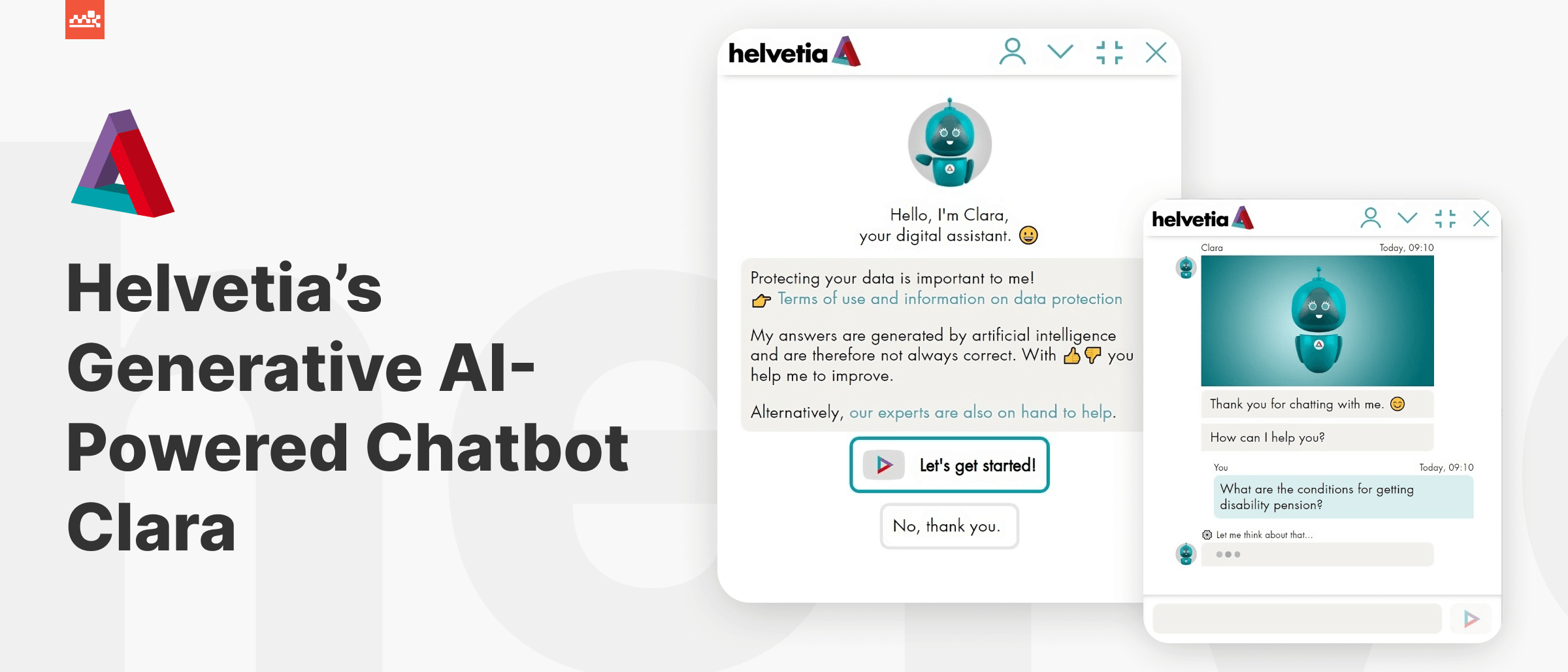
This move demonstrates the Gen AI potential to transform the way insurers interact with their consumers:
- Customized Quotes Based on Needs
Gone are the days of generic quotes. The intelligent algorithms empower businesses to deliver personalized estimates derived from individual specifications, like age, location, driving history, and lifestyle. Such a tailored approach ensures clients receive the most relevant and cost-effective coverage options. - Policy Clarification
Insurance agreements are notoriously complex and filled with jargon. Language models simplify this by interpreting lengthy documents into easily digestible summaries. This helps with understanding the program, exclusions, and benefits, eliminating misunderstandings. - First-tier Claim Registration and Classification
AI voice assistants or chatbots can guide customers through the submission procedure, ensuring all necessary information is collected accurately and efficiently. They not only reduce the burden on human agents but also streamline the initial stages of claims processing, leading to faster resolution times. Generative AI also assists in classifying requests and routing them to the appropriate department or agent for further handling.
Automotive
The auto industry is increasingly turning to GAI to improve the car ownership experience. Here’s how:
- Personalized Car Manual Assistance
Intelligent tools decipher complex information, supplying drivers with targeted tips on maintenance, troubleshooting guides, and feature explanations. Transforming lengthy manuals into accessible content empowers people to better understand and sustain their vehicles. - Predictive Maintenance
These systems also use vehicle data and historical patterns to predict potential issues before they escalate. Such a proactive approach can alert automobile owners to upcoming upkeep needs, suggest specific actions, and even schedule appointments with service centers, ensuring optimal performance and longevity. - Model Comparison
Car buying is overwhelming with countless designs and specifications to consider. The technology simplifies this process by providing exhaustive side-by-side model evaluations. By analyzing individual preferences, budget constraints, and desired features, it recommends the most suitable autos, enhancing decision-making and driving sales.
Roughly 50% are eager to adopt Generative AI for their in-car voice assistants. Are you equipped to handle this trend?
Potential Pitfalls and Mishaps of Generative AI in Customer Support
The advantages of intelligentization are undeniable, but its limitations must be acknowledged for successful implementation.
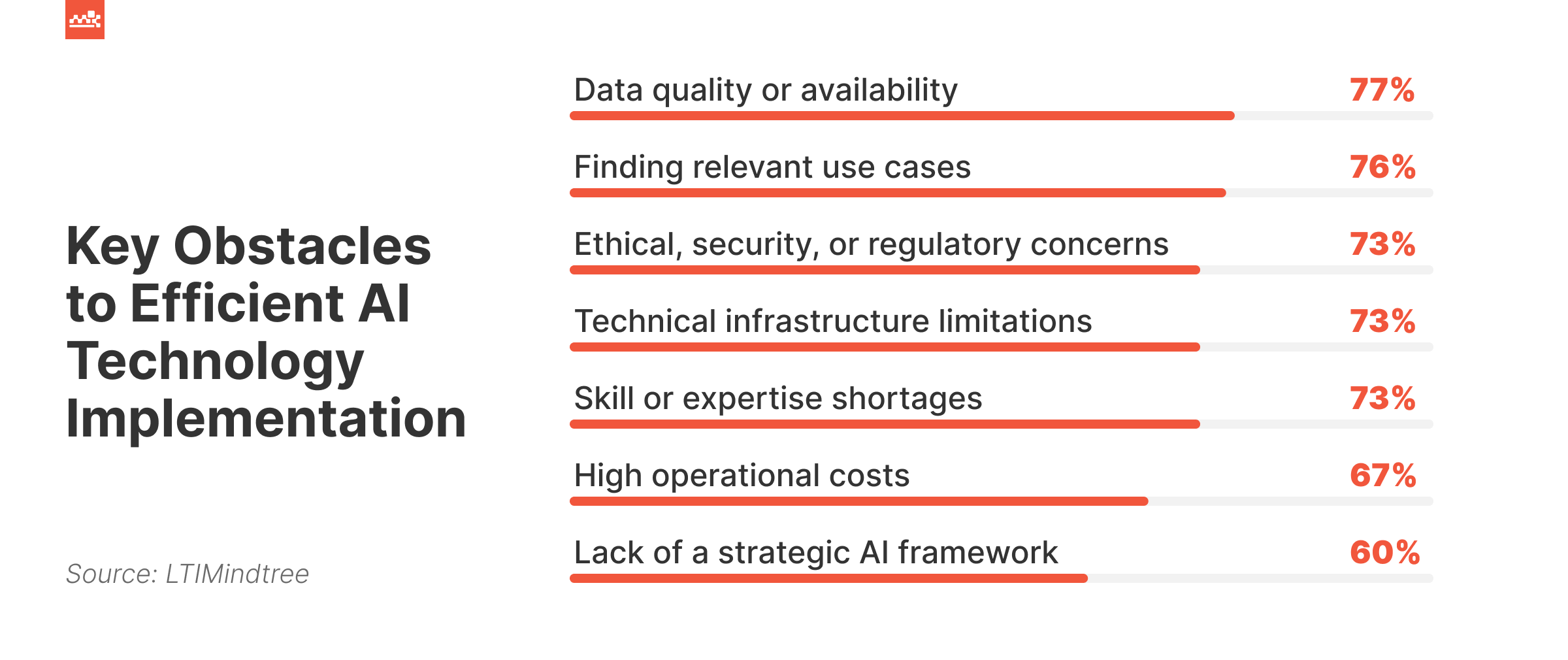
- Hallucinations
LLMs sometimes produce plausible-sounding but inaccurate or irrelevant responses. As a result, consumers get confused or misinformed, which undermines the brand’s reputation. - Fragmented Customer Experiences
Deploying standalone AI solutions without integrating them into a cohesive omnichannel strategy creates a disjointed digital journey. This lack of integration transforms into inconsistencies in replies and loss of context as users switch between channels. - Data Bias and Inaccuracies
LLMs are only as good as the data they are trained on. Erroneous, incomplete, or biased datasets cause flawed reasoning that perpetuates existing biases. - Repetitive and Unsatisfying Interactions
If not designed carefully, GAI interactions can become redundant and frustrating for customers. This occurs when the system fails to understand the nuances of a client’s request or provides generic answers.
The inability to address these challenges leads to considerable losses, both financial and reputational. In fact, there are a few stories about such flops:
- A Chevrolet dealership’s chatbot, powered by ChatGPT, mistakenly agreed to sell a 2024 Chevy Tahoe for just $1 after a user manipulated its replies.
- Air Canada’s bot erroneously promised a passenger a bereavement fare discount that was not applicable under the airline’s policy. When the customer sought to claim the deal, the corporation denied responsibility, attributing the error to the assistant.
- A lawsuit against UnitedHealth alleges that the company’s AI model, nH Predict, was used to systematically deny coverage to elderly patients under Medicare Advantage Plans, potentially resulting in harm.
These examples underscore the importance of meticulous planning and execution when implementing Generative AI for customer service. If you’re unsure of how to navigate such complexities, our team at Master of Code can provide professional advice and tailored solutions to help you avoid similar traps. Don’t hesitate to reach out to us for expert guidance.
Wrapping Up
Gen AI has competencies that include making long-form content concise and digestible, pulling information from multiple domains, and offering personalized, contextual solutions with vast variability. By capitalizing on these functionalities, businesses can create unique experiences for their clients that are tailored to their needs.
It’s worth noting that we discussed just a few examples of the many use cases of Generative AI for customer service. The possibilities are virtually endless, and as technology continues to mature, companies are sure to find new and innovative ways to incorporate it into their CX strategies.
At Master of Code, we’re passionate about helping brands exploit the benefits of GAI to transform their client care tactics. If you’re interested in learning more about how you can employ intelligent applications to provide the greatest value to your consumers, we’d love to chat!
Ready to build your own Conversational AI solution? Let’s chat!






